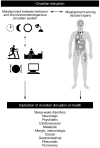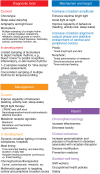Circadian disruption and human health
- PMID: 34596053
- PMCID: PMC8483747
- DOI: 10.1172/JCI148286
Circadian disruption and human health
Abstract
Circadian disruption is pervasive and can occur at multiple organizational levels, contributing to poor health outcomes at individual and population levels. Evidence points to a bidirectional relationship, in that circadian disruption increases disease severity and many diseases can disrupt circadian rhythms. Importantly, circadian disruption can increase the risk for the expression and development of neurologic, psychiatric, cardiometabolic, and immune disorders. Thus, harnessing the rich findings from preclinical and translational research in circadian biology to enhance health via circadian-based approaches represents a unique opportunity for personalized/precision medicine and overall societal well-being. In this Review, we discuss the implications of circadian disruption for human health using a bench-to-bedside approach. Evidence from preclinical and translational science is applied to a clinical and population-based approach. Given the broad implications of circadian regulation for human health, this Review focuses its discussion on selected examples in neurologic, psychiatric, metabolic, cardiovascular, allergic, and immunologic disorders that highlight the interrelatedness between circadian disruption and human disease and the potential of circadian-based interventions, such as bright light therapy and exogenous melatonin, as well as chronotherapy to improve and/or modify disease outcomes.
Conflict of interest statement
Figures



